
Dose of memories of the PC in the 90s, focusing on new classic elements that are sure to make you smile.
The 90's was a glorious period for the PC. Continuous technical innovations added to the birth of new genres. Likewise, we saw how others evolved to achieve a prestige that lasts today. In the first part of this tribute to the PC, we focused on hardware and technology, but this time we want to recall those unforgettable titles, sagas and curiosities that we were part of during that golden age. Here continues our story.
Large boxes, beautiful manuals
How pretty those big game boxes were. The arts printed on the outside made them shine on our bookshelf. Inside we found floppy disks or CDs, an illustrated manual, customer service brochures, and sometimes extra material like maps or diaries about the story. For example, the edition of Baldur's Gate 2 was incredible. No need for collector editions or additional cost. How many big box games do you keep?
Anti-piracy systems
Copying games started out as an innocent practice among friends, but over the years it spread counterproductively. The companies, aware of this, managed to add puzzles to their games that could only be solved with the keys included in the original box. From there came the Monkey Island roulettes or the Day-the-Tentacle drum-salad plans. In Flashback (1992) we are asked for keys from the second level to access new missions. Other games aimed higher and used keys that were combined with filters to avoid photocopying. In these cases, the player spent hours transcribing all the solutions.

Fish tank magazines, our bibles
We had two ways to discover new games: the word of mouth of a lifetime or the magazines dedicated to the PC. The fireproof Micromania had been with us since the microcomputer era, and during the 90's it continued unstoppable, offering us interesting information about the huge catalog of games that was sprouting up. Over the years we witnessed various formats, but the newspaper type was one of the most loved. We enjoy news, reports, genre sections, Reviews, and our life saver, the guides. The CDs with demos of Micromania were a gift, especially in the pre-internet era. The expansion of the video game facilitated the appearance of other publications: PC World, PC Actual, PCmanía … Some occasionally offered gift games.
Living stuck in adventure
The adventure went through a golden age in the 90s until it fell into a dry dock in recent years. During that period, adventurers suffered many moments of despair. In Sierra's graphic adventures we died endlessly trying absurd combinations; On the other hand, with LucasArts we did not clap, but we could spend weeks stuck in their crazy puzzles. The most widely used unclogging method was consulting a family member or friend. And if we did not solve the situation with those, there was nothing left to do but wait for the long-awaited guide from Micromania. The puzzles of Day of the Tentacle through the past, present, and future were as original as they were intricate. See all there is to do with the poor hamster until he ends up in the generator. Also the 'pixel hunting' of adventures like Indiana Jones and the Fate of Atlantis destroyed more than one mouse with a ball. Although if there was one that made a lot of adventurers throw in the towel, it was The Dig.
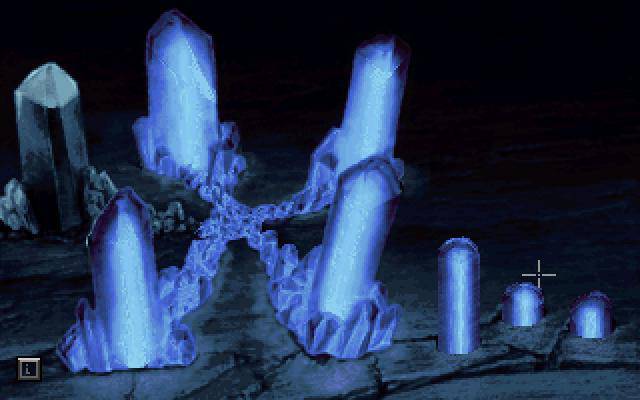
Video game stores and mail order
In times where digital copies didn't exist, moving to a store or ordering by mail were the only possibilities. Video games in the 1990s were sold in bazaars, neighborhood stores, department stores, or a few specialty stores. Of the latter, the Mail Center was one of the most popular establishments. Game rental stores also appeared, where for a few pesetas we could enjoy a launch throughout the weekend.
The age of the RTS
Westwood Studios coined the term RTS to encompass those real-time strategy games released during the 1990s. Dune 2 (1992) and Command & Conquer (1995) were able to bring together several generations around a computer. The one of advice that we exchanged with our parents! Blizzard joined the contest with the Warcraft and Starcraft sagas, which were supported by a wide community of users. However, there was much more during this decade. Microsoft Game Studios released Age of Empires (1997), a breath of fresh air that brought parents and children back together on the battlefield. Oh, and let's not overlook the Spanish hit Commandos (1998). Okey dokey!
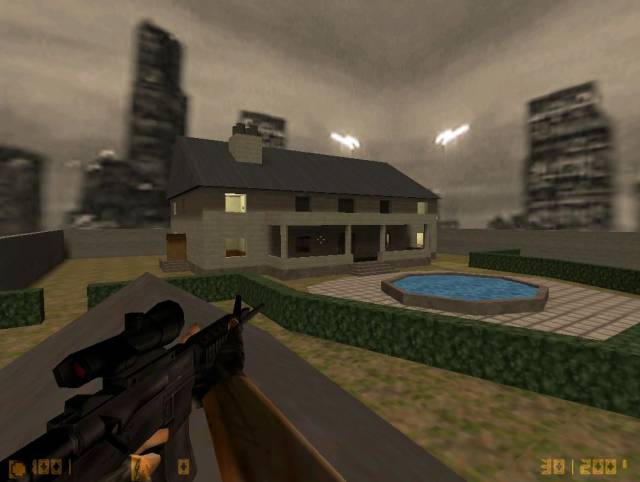
Cyber café evenings and online games
In the mid-1990s, the network of networks was established in many homes. A magical moment that allowed us to discover the online PVP and cooperative modes of numerous games. Tools like the extinct Gamespy appeared in order to allow us to quickly find games. Unfortunately, connecting to our old 28, 33, or 56 kbps modems to the Internet meant having your phone line busy. As if this were not enough misfortune already, the Internet was quantified as a call, and since Telefónica had a monopoly at the time, the blades on the bill were devastating. Tense moments were experienced in the family nucleus with parents pulling cables, or directly hiding the modem in remote corners. In 2000, thanks to the pressure of netizens, the desired flat rate was achieved.
Internet cafes were the answer to a slow and expensive Internet. The client paid cheap rates for time of use and could take a seat at one of the tables full of computers with the games of the moment: Quake 2, Diablo, Half Life, Starcraft … Internet cafes became our meeting place when leaving of class. Parallel to the birth of these venues, Lan-parties landed, massive events where attendees came loaded with their PC. There we enjoyed for several days fast connections for multiplayer tournaments, file sharing and various workshops. The Euskal Party was the first Spanish Lan-party to be held in 1994. Later, many others followed, such as the famous Campus Party. Did you get to go to any of these first meetings?
A mod to rule them all
Modifying games by amateurs is as old a practice as the industry itself. Many mods were born in order to extend playable features, but they were so good that they ended up making their own. This was the case of Counter Strike, a mod created by fans for the multiplayer of Half Life (1998). The beta released in 1999 became so popular that it successfully overshadowed Quake 3 and Unreal Tournament. Valve, a studio that was released with Half Life at the time, signed the creators and incorporated Counter Strike for free with the purchase of their game. Counter Strike's success was unmatched. He was the king of cybercafés and a multitude of competitions were built around him. Small Terrorist VS Antiterrorist fights we dispute. Quake was key to the release of Half Life and Counter Strike, I feel both built on the basis of an engine modification created by id Software.

Emulators
In the mid-1990s the first emulators emerged. Through these programs, a title from another system could be played on a PC with an experience very similar to that of the original. The fame of the emulation uncovered the censorship suffered by Japanese games when landing in the West, as well as gross translation errors. This encouraged many fan groups to create improved versions of their favorite games. This practice was called 'romhacking'. It should be said that not everything was "improvements", there were also hilarious parodies such as 'La Lellenda de Cerda' (1999) by Charnego Translations. Some of the most popular emulators of that time were MAME, ZSNES or Kgen.
MMORPG addiction
In the 1990s, massively multiplayer online role-playing games – formerly known as MUD (Multi-User Dungeon) – wreaked havoc with the role-playing community. In 1997 Richard Garriott (Lord British in the Virtual World) released Ultima Online and coined the genre as MMORPG. Thousands of players paid without question the monthly fee with the desire to be part of the endless curiosities that the title generated. Micromanía reserved a few monthly pages to tell the best anecdotes: the deadliest raids, player weddings and even demonstrations. Although nothing surpassed the news of the murder of Lord British at the hands of a player.
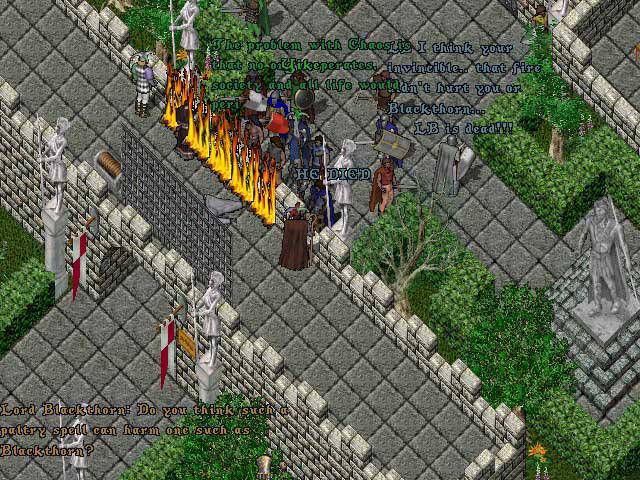
The Bank of Britain was a coming and going of new travelers. Also a meeting point to go on adventures with our friends. But far from the protection of the city guards, the deep red tone PKs (player killers) awaited their next victim. The popularity of the game encouraged many fans to create unofficial servers at no cost. There small families formed where players and GMs collaborated to plan raids and various celebrations. Our second life.
Ultima Online marked the beginning of the rise of the MMO and, years later, as many as Lineage (1998) and, above all, Everquest (1999), took the witness, gathering thousands of followers. It is also worth mentioning that Spanish MMO called La Prisión. Did you try it?
Controversial games
Censorship has been accompanying us from what is known, but before it was wilder and unjustified. Many religious, political, sexual, and violent elements were magically removed or transformed into others. However, when violence was part of the "fun", it was banned in certain territories. Many of us played Carmageddon (1997), a controversial title for pedestrian abuse. The general press and associations of various kinds carried out a campaign of harassment and demolition towards the title. But they got the opposite effect: everyone wanted to play it. In order to go on sale in the UK, pedestrians were replaced by zombies; and in Germany and India by robots. In other countries such as Brazil it was banned without question. In Spain, weeks before the launch of Carmageddon II (1998), El Corte Inglés suspended the sale in all its centers.

Many other titles sadly jumped to the press for their violent content: Duke Nukem 3D (1996), Postal (1997) or Kingpin: Life of Crime (1999). The company id Software never escaped criticism for its FPS, with Doom (1992) even being blamed by some media for the Columbine High School massacre.
Terror and FMV
The use of 'full motion video' (FMV) spread during the 1990s in games of various genres. However, in horror adventures the use of real actors became especially fashionable. His goal was to create an interactive film, although the staging left much to be desired. You just have to take a look at The 7th Guest (1993), where ghosts surprised us mounting their show. Now perhaps it is quite embarrassing, but as youngsters it was a little scary. Other titles left the first person view and let us see the leading actress, as in the adventure Phantasmagoria by Roberta Williams. Video footage worthy of B-series tapes, and seedy today and always, but they had their what, right?
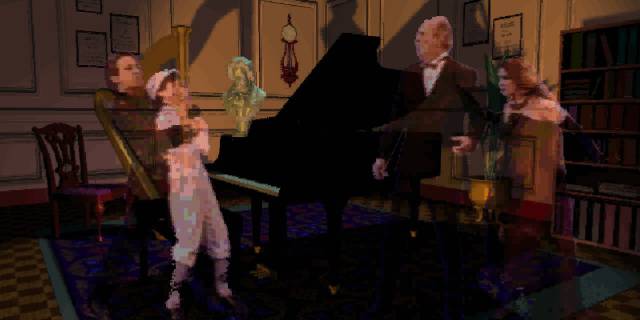
The transition to CD-Rom
Due to the graphic advancement and the irruption of the cinematics, the games became increasingly heavy, so storing them on diskettes was no longer viable. This is how new games and classic reviews were released on CD-Rom. The adventures that abused the FMV accumulated a lot of records. Final Fantasy VII on PC occupied 4 discs, while Phantasmagoria reached 7 discs.
The rebirth of the western role
RPG games for PC continued to incorporate interesting proposals. We enjoy Ultima VII, Lands of Lore or Eye of the Beholder II. Still, the genre felt corsetted and visually unappealing. During the second half of the 90s, new companies entered willing to promote a genre anchored at its roots. In 1996 Blizzard released Diablo, an ARPG that was enthusiastically received for its dungeons, graphics, and addictive gameplay. In addition, it implemented a cooperative mode of up to 4 players.
Interplay also wanted to collaborate with the cause, but from a totally different approach. Fallout (1997) plunged us into an intriguing post-nuclear world as denizen of refuge 13. X-Com inspired turn-based combat emerged, as well as a system of decisions that broadened the spectrum of possibilities to progress in history. A year later, Fallout 2 outperformed the original. But the best was yet to come. Brian Fargo had two aces up his sleeve: the Forgotten Realms and D&D licenses. And Bioware was going to be chosen to materialize both elements in an RPG. This is how Baldur's Gate emerged, a masterpiece that revitalized the genre and set a new standard for upcoming titles.
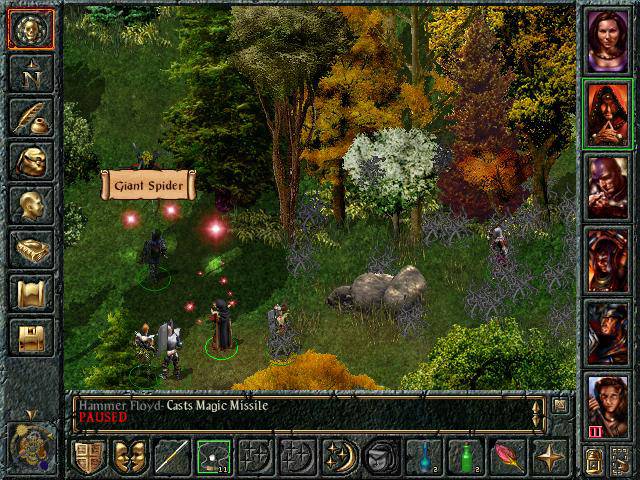
We will never forget the phrases of the chatty characters of Baldur's Gate (Eye to eye, eye to eye!), Nor the epicity of the Sword Coast. Baldur's Gate 2 did nothing but refine and expand the formula. Under the same Infinity engine, the impressive Planescape Torment closed a wonderful decade for the CRPG.
Big bumps
Commercial failures have always been present in the industry, and in this period there were some well known. Ultima IX (1999) enjoyed good graphics, but was criticized for being incomplete and not linking to previous installments. Also, the huge amounts of bugs just plunged him into the well.
Messiah, the fallen angel game, was featured for years on the pages of numerous publications in the late 1990s. David Perry, who had a good reputation after MDK, boasted in the 'Real Time Deformation and Tesselation' system media. , which made the number of polygons adapt according to the player's hardware and the level of the game. Messiah was finally released in 2000, but criticism of its free violence and the number of bugs took its toll on sales.
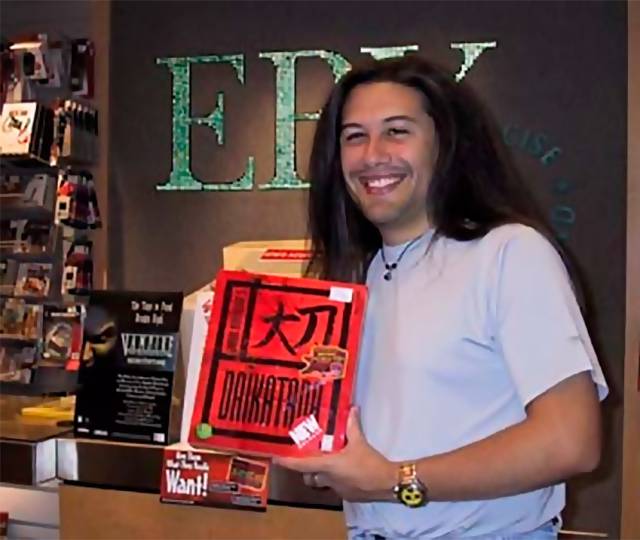
However, the biggest bump was Daikatana. John Romero's play alongside Ion Storm was marred by recurring internal disagreements, design issues, and various delays. When it went on sale in 2000, its technology was very outdated and games like Quake 3 or Unreal Tournament gobbled it up. Daikatana cost a whopping $ 40 million.
Play god
In 1989 Bullfrog released Populous, the starting point for a series of titles created under the premise of "games of being god." The player could shape the world as he pleased without being forced to follow a plot. Peter Molyneux made us enjoy his wild ideas throughout the decade. We burst out laughing at Theme Hospital (1997) with her made-up illnesses and a wacky receptionist who dropped pearls like "we beg patients to be … patients."
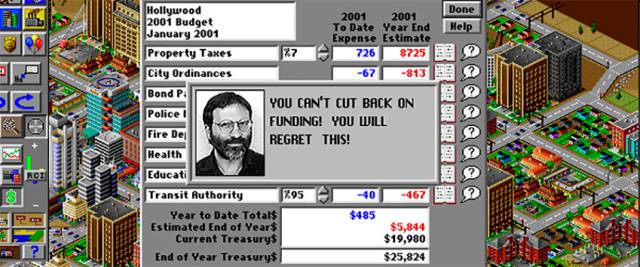
Maxis also embarked on the journey of being god games from simulating … anything. After their first hit Sim City (1989), they released Sim City 2000 (1993) which improved substantially with endless new options and change to the isometric view. We started by creating our ideal terrain and then we designed urban planning trying to please the population. We also had to adjust taxes to avoid targeting the main managers of each area. After a while of play, our vile side appeared and we sent everything to fry asparagus with a disaster. The pleasure of destruction.
Sports management made in Spain
PC Fútbol was a popular sports management saga by Dinamic Multimedia. At our trusted kiosk we were able to buy a title that marked our leap into a new manager experience. Once inside we had to catapult a team through a complete transfer market, financial management and various tactics. It had a lot of crumb and complex operation for many of us, but it was addictive. Also, if we were bored of the manager mode we could play the matches. New features were implemented in each installment until achieving success in PC Fútbol 5.0 (1996). Mythical were those covers with Michael Robinson, the face and voice of the saga from PC Soccer 2.0 to 7.
Dinamic adapted the PC Soccer format for the discipline of basketball in PC Basket, another great management saga that fascinated fans on the field. Surely more than one had the audacity to sign Michael Jordan to burst the meetings on points.
We can consider ourselves lucky to have lived through a decade of creative waste for the PC. A time of discovery and passion. The milestones achieved in the 90s made way for many works of the following decade and, even today, they remain a benchmark for so many others. We hope that these lines have transported you to precious memories of youth. Many other anecdotes have remained in the pipeline, but perhaps in the next nostalgic attack we will continue adding new episodes of our past fish. Now yes, turn off the computer and go to bed!

